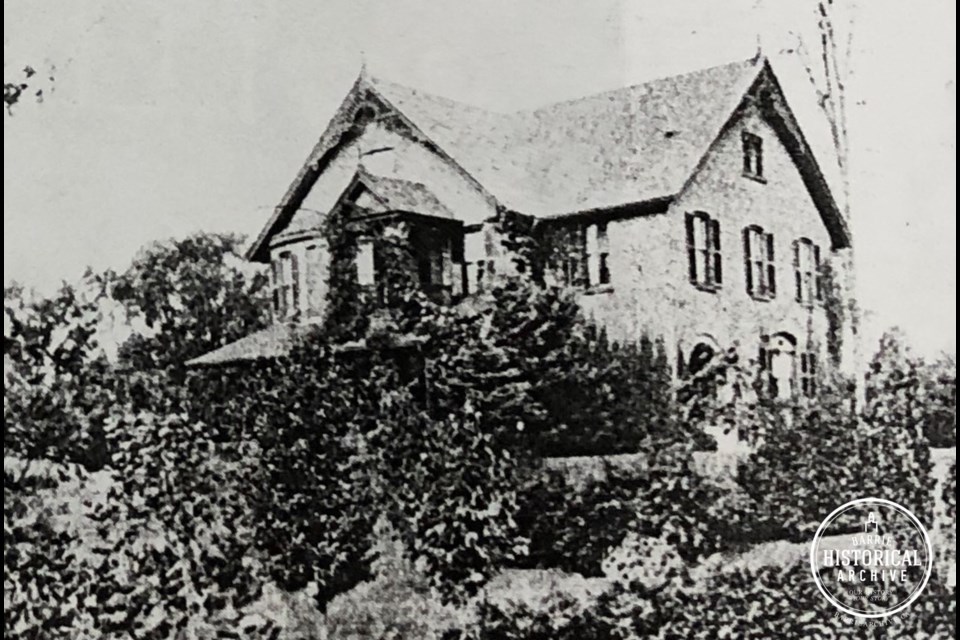This ongoing series from Barrie Historical Archive curator Deb Exel shows old photos from the collection and one from the present day, as well as the story behind them.
Rockforest II
James Lawrence Rogerson (J.R.) Cotter was born Jan. 26, 1836 in Cork County, Ireland, the youngest of six children, and the only surviving one for some time. His father brought the family to Canada in 1837, where they settled in Newmarket and James attended the Newmarket Grammar School.
In 1853, Cotter opened a law firm in Barrie for D’Arcy Boulton, a lawyer and founder of the Hussars — a mounted infantry company of which Maj. Joseph Rogers was a lieutenant. As a student in Toronto, J.R. practised with eminent layer J.J. Vance in 1854-55.
A year later, Cotter was back in Barrie, managing the office of Reeve Henry B. Hopkins who was visiting the ‘Old Land’. After a year of being in charge of the Reeve’s office, Cotter moved to Dunnville, Ont., and opened his own law office.
J.R. married George Lount’s daughter, Hannah, in 1857. George Lount, originally from Pennsylvania, came to Whitchurch Township about 1811. He and his brother, Samuel, settled near Holland Landing working as a land surveyor (George) and a woodsman (Samuel). In 1846, when the registry office was relocated to Barrie, Lount moved as well, later importing black walnut trees from his former U.S. home to Barrie in 1850.
In 1862, Cotter was appointed Crown attorney of Simcoe County and was back in Barrie again. He held that position for 61 years and was respected for his strong but fair approach to justice. Always with a mindset to be merciful, it was his policy to let young, first-time offenders have a chance to redeem themselves.
The Cotters built their home, Rockforest, where 54 Peel St. once stood in the historic neighbourhood known as The Grove. The house was named for the town in Ireland that J.R.’s family had come from. They lived there until they sold in 1897. The beautiful home and coach house were later demolished in the 1980s to make way for townhouses.
In 1898, the Cotters gave a stunningly elaborate wedding for their daughter, Wilhelmina. It must have been the most brilliant social event of the year as the newspaper devoted almost four full columns to covering it in the greatest detail.
From the abundant and varied floral décor within Trinity Anglican church (where the full choir participated in the musical service), to the elaborate description of the bride’s attendants’ outfits (oyster grey satin with steel trimmings, large black velvet picture hats with steel crowns and black plumes, American Beauty roses attached to shepherd’s crooks and Victorian bonnets with baskets of American Beauty roses for the little bridesmaids), followed by over-the-top coverage of what the prominent women guests were wearing, the paper outlined what must have been an incredibly fashionable wedding.
Because they were between homes at the time, the lavish and exotic wedding luncheon was held on the lawn of the Cotter’s elder daughter Margaret’s home at what was then 145 Owen St.
The paper went on to list almost 170 gifts that the bride had received and from whom: many of the names quite recognizable… Dyments, Lounts, Boys, Creswicke, McConkey, Strathy, Ardagh, Gowan, Pepler, Lally, Bird and McCarthy to name a few.
The Cotter’s new house, Rockforest II, was built on Owen Street (now No. 168) about 1900. In June 1907, J.R. and Hannah celebrated their 50th wedding anniversary with a large reception at their new, modern home.
It is said that at the time of Cotter’s death in 1928, there were 250 black walnut trees on the Rockforest estate.



